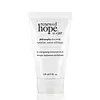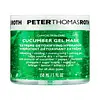What's inside
What's inside
 Key Ingredients
Key Ingredients

No key ingredients
 Benefits
Benefits

 Concerns
Concerns

 Ingredients Side-by-side
Ingredients Side-by-side

Water
Skin ConditioningPEG-8
HumectantCellulose
AbsorbentButylene Glycol
HumectantGlycerin
HumectantPEG-7 Glyceryl Cocoate
EmulsifyingHamamelis Virginiana Water
AstringentPhenoxyethanol
PreservativeCarbomer
Emulsion StabilisingSaccharide Isomerate
HumectantBenzophenone-3
UV AbsorberPanthenol
Skin ConditioningAlcohol
AntimicrobialChlorphenesin
AntimicrobialSodium Hydroxide
BufferingParfum
MaskingDisodium EDTA
Ananas Sativus Fruit Extract
Skin ConditioningPropylene Glycol
HumectantCitric Acid
BufferingGuar Hydroxypropyltrimonium Chloride
Skin ConditioningSodium Citrate
BufferingPanthenyl Triacetate
Taraxacum Officinale Rhizome/Root Extract
Skin ConditioningPantolactone
HumectantHydroxyethylcellulose
Emulsion StabilisingHydroxypropylcellulose
EmulsifyingCentaurea Cyanus Flower Extract
AstringentBHT
AntioxidantEthylhexylglycerin
Skin ConditioningCI 77891
Cosmetic ColorantCI 42090
Cosmetic ColorantCI 17200
Cosmetic ColorantWater, PEG-8, Cellulose, Butylene Glycol, Glycerin, PEG-7 Glyceryl Cocoate, Hamamelis Virginiana Water, Phenoxyethanol, Carbomer, Saccharide Isomerate, Benzophenone-3, Panthenol, Alcohol, Chlorphenesin, Sodium Hydroxide, Parfum, Disodium EDTA, Ananas Sativus Fruit Extract, Propylene Glycol, Citric Acid, Guar Hydroxypropyltrimonium Chloride, Sodium Citrate, Panthenyl Triacetate, Taraxacum Officinale Rhizome/Root Extract, Pantolactone, Hydroxyethylcellulose, Hydroxypropylcellulose, Centaurea Cyanus Flower Extract, BHT, Ethylhexylglycerin, CI 77891, CI 42090, CI 17200
Water
Skin ConditioningButylene Glycol
HumectantCucumis Sativus Fruit Extract
EmollientAnanas Sativus Fruit Extract
Skin ConditioningVaccinium Myrtillus Fruit/Leaf Extract
AstringentCarica Papaya Fruit Extract
Skin ConditioningAcer Saccharum Extract
Skin ConditioningSaccharum Officinarum Extract
MoisturisingAloe Barbadensis Leaf Juice
Skin ConditioningChamomilla Recutita Flower Extract
MaskingChamomilla Recutita Flower Oil
MaskingCitrus Limon Fruit Extract
MaskingCitrus Aurantium Dulcis Fruit Extract
MaskingMangifera Indica Fruit Extract
Skin ConditioningSodium PCA
HumectantAllantoin
Skin ConditioningGlycerin
HumectantPropylene Glycol
HumectantDisodium EDTA
Sodium Hydroxide
BufferingCitric Acid
BufferingCarbomer
Emulsion StabilisingTriethanolamine
BufferingPolysorbate 20
EmulsifyingPotassium Sorbate
PreservativeSodium Benzoate
MaskingPhenoxyethanol
PreservativeCI 19140
Cosmetic ColorantCI 42090
Cosmetic ColorantWater, Butylene Glycol, Cucumis Sativus Fruit Extract, Ananas Sativus Fruit Extract, Vaccinium Myrtillus Fruit/Leaf Extract, Carica Papaya Fruit Extract, Acer Saccharum Extract, Saccharum Officinarum Extract, Aloe Barbadensis Leaf Juice, Chamomilla Recutita Flower Extract, Chamomilla Recutita Flower Oil, Citrus Limon Fruit Extract, Citrus Aurantium Dulcis Fruit Extract, Mangifera Indica Fruit Extract, Sodium PCA, Allantoin, Glycerin, Propylene Glycol, Disodium EDTA, Sodium Hydroxide, Citric Acid, Carbomer, Triethanolamine, Polysorbate 20, Potassium Sorbate, Sodium Benzoate, Phenoxyethanol, CI 19140, CI 42090
 Reviews
Reviews

Ingredients Explained
These ingredients are found in both products.
Ingredients higher up in an ingredient list are typically present in a larger amount.
Ananas Sativus Fruit Extract comes from the pineapple fruit. Pineapples are native to South America. The components of pineapple give it mild exfoliating and skin nourishing properties.
Pineapples contain Vitamin C, Vitamin B6, copper, potassium, niacin, and other minerals. It also contains many phytochemicals, including ferulic acid, coumaric acid, arbutin, and more. These help condition the skin.
Bromelain can be found in all parts of a pineapple. It is a mixture of enzymes and is mildly exfoliating.
Learn more about Ananas Sativus Fruit ExtractButylene Glycol (or BG) is used within cosmetic products for a few different reasons:
Overall, Butylene Glycol is a safe and well-rounded ingredient that works well with other ingredients.
Though this ingredient works well with most skin types, some people with sensitive skin may experience a reaction such as allergic rashes, closed comedones, or itchiness.
Learn more about Butylene GlycolCarbomer is a polymer of acrylic acid. Its main role is to create a gel consistency.
A high amount of carbomer can cause pilling or balling up of products. Don't worry, most products contain 1% or less of carbomer.
Ci 42090 is a synthetic dye created from petroleum. It is used to give a bright blue color to cosmetics, medicine, and food.
Citric Acid is an alpha hydroxy acid (AHA) naturally found in citrus fruits like oranges, lemons, and limes.
Like other AHAs, citric acid can exfoliate skin by breaking down the bonds that hold dead skin cells together. This helps reveal smoother and brighter skin underneath.
However, this exfoliating effect only happens at high concentrations (20%) which can be hard to find in cosmetic products.
Due to this, citric acid is usually included in small amounts as a pH adjuster. This helps keep products slightly more acidic and compatible with skin's natural pH.
In skincare formulas, citric acid can:
While it can provide some skin benefits, research shows lactic acid and glycolic acid are generally more effective and less irritating exfoliants.
Most citric acid used in skincare today is made by fermenting sugars (usually from molasses). This synthetic version is identical to the natural citrus form but easier to stabilize and use in formulations.
Read more about some other popular AHA's here:
Learn more about Citric AcidDisodium EDTA plays a role in making products more stable by aiding other preservatives.
It is a chelating agent, meaning it neutralizes metal ions that may be found in a product.
Disodium EDTA is a salt of edetic acid and is found to be safe in cosmetic ingredients.
Learn more about Disodium EDTAGlycerin is already naturally found in your skin. It helps moisturize and protect your skin.
A study from 2016 found glycerin to be more effective as a humectant than AHAs and hyaluronic acid.
As a humectant, it helps the skin stay hydrated by pulling moisture to your skin. The low molecular weight of glycerin allows it to pull moisture into the deeper layers of your skin.
Hydrated skin improves your skin barrier; Your skin barrier helps protect against irritants and bacteria.
Glycerin has also been found to have antimicrobial and antiviral properties. Due to these properties, glycerin is often used in wound and burn treatments.
In cosmetics, glycerin is usually derived from plants such as soybean or palm. However, it can also be sourced from animals, such as tallow or animal fat.
This ingredient is organic, colorless, odorless, and non-toxic.
Glycerin is the name for this ingredient in American English. British English uses Glycerol/Glycerine.
Learn more about GlycerinPhenoxyethanol is a preservative that has germicide, antimicrobial, and aromatic properties. Studies show that phenoxyethanol can prevent microbial growth. By itself, it has a scent that is similar to that of a rose.
It's often used in formulations along with Caprylyl Glycol to preserve the shelf life of products.
Propylene Glycol is an odorless, colorless liquid. As a humectant, it helps skin retain moisture. It also aids in delivering active ingredients.
Another role of this ingredient is preventing a product from melting or freezing. Propylene glycol also adds antimicrobrial properties to a product, elongating product lifespan.
This ingredient is considered an organic alcohol and commonly added into both cosmetics and foods.
Those with sensitive skin or conditions may develop a rash when using this ingredient.
Learn more about Propylene GlycolSodium Hydroxide is also known as lye or caustic soda. It is used to adjust the pH of products; many ingredients require a specific pH to be effective.
In small amounts, sodium hydroxide is considered safe to use. However, large amounts may cause chemical burns due to its high alkaline.
Your skin has a natural pH and acid mantle. This acid mantle helps prevent harmful bacteria from breaking through. The acid mantle also helps keep your skin hydrated.
"Alkaline" refers to a high pH level. A low pH level would be considered acidic.
Learn more about Sodium HydroxideWater. It's the most common cosmetic ingredient of all. You'll usually see it at the top of ingredient lists, meaning that it makes up the largest part of the product.
So why is it so popular? Water most often acts as a solvent - this means that it helps dissolve other ingredients into the formulation.
You'll also recognize water as that liquid we all need to stay alive. If you see this, drink a glass of water. Stay hydrated!
Learn more about Water